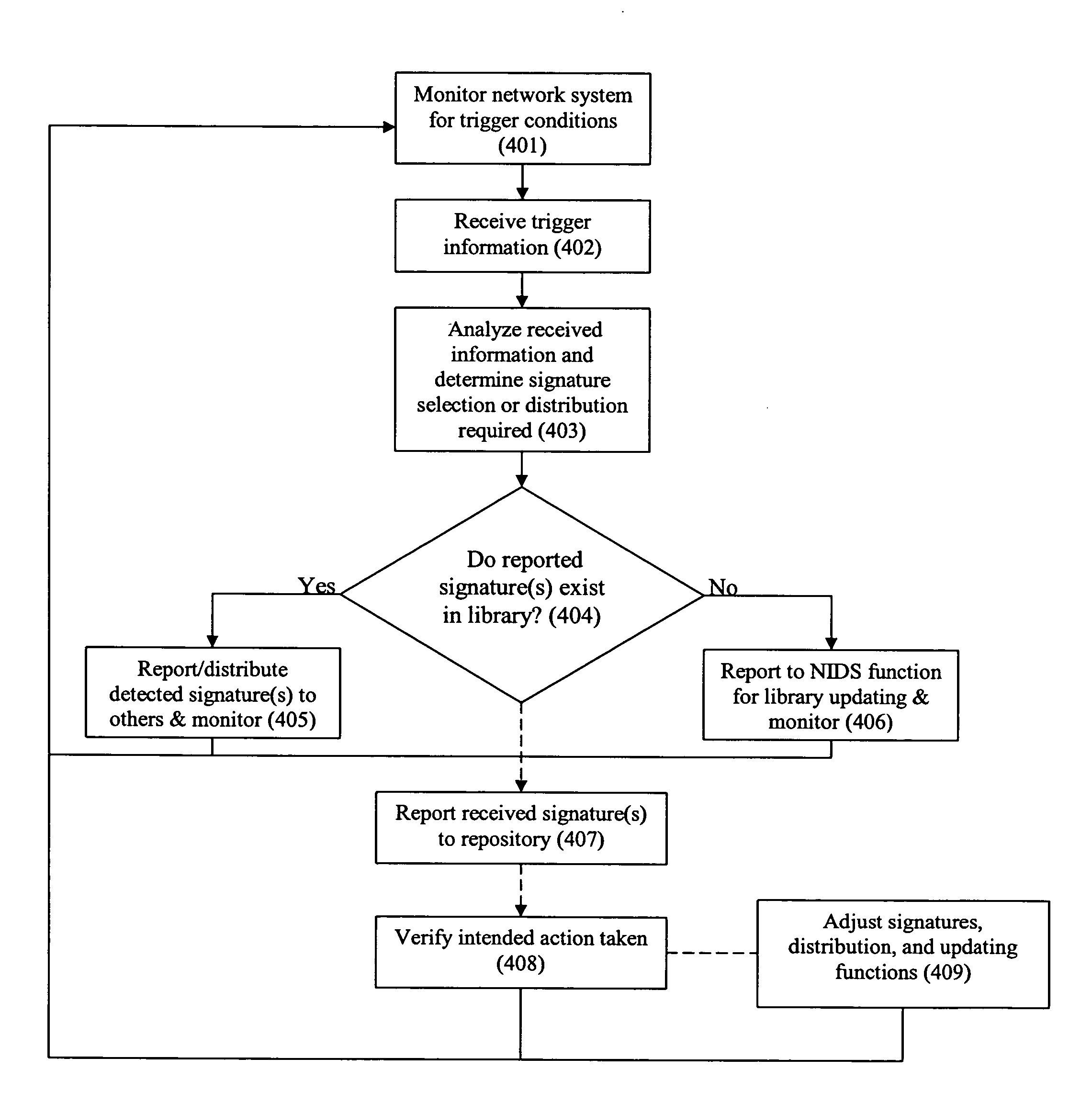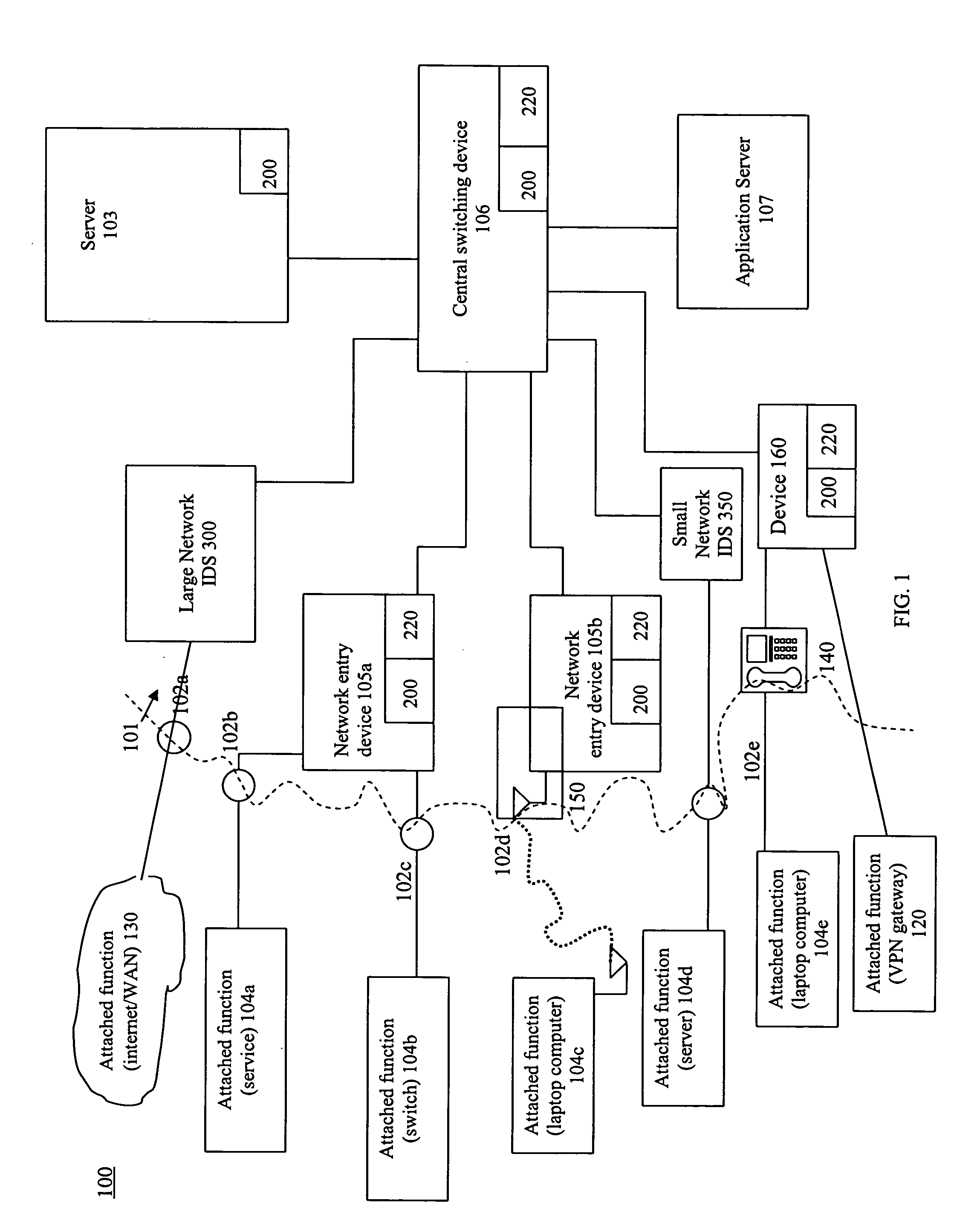[0016] The present invention is a system and related method for distributing intrusion signatures to all devices forming part of the intrusion
reporting system of an IDS. In particular, the present invention is a system and method in which all network infrastructure devices having intrusion detection functionality are provisioned with intrusion signatures. Each such infrastructure device includes a set of intrusion signatures that may not be exactly the same as the signature sets of the other infrastructure devices. Some of the devices may have more signatures in the set than others. The devices including the intrusion detection functionality may be stand-alone NIDS, network entry switches with some NIDS functionality,
core network switching devices with some NIDS functionality, and routers and gateways with NIDS functionality. A network infrastructure device may also include a portion of the functionality associated with the present invention. Further, the functions to be described herein may be embodied in a single device, in a central device, in an
edge device, in a centralized manner or in a distributed manner including a plurality of network infrastructure devices. An analysis function of the system uses network information, including detected intrusion signatures, location information, packet information, and / or other information of interest to the
network administrator to optimize detection capability and minimize forwarding
impact on network system traffic.
[0017] In general, the present invention provides for the dynamic transfer of intrusion signatures among IDS functions of the network system. The analysis function includes one or more algorithms employed to determine which intrusion signatures are to be transferred to which IDS functions, including to all IDS functions, or a portion thereof. The analysis function improves network system IDS detection in response to triggering conditions that may include, but are not limited to, harmful network intrusions coming from attached functions, network infrastructure entry devices, other network infrastructure devices, such as central forwarding devices and servers, as well as affected agents and functions of the network system. The triggering condition may also be something other than a reactive mechanism associated with a detected intrusion or other type of network anomaly. Instead, it may be a timed, administered, or otherwise planned condition. For the purpose of this description, any such condition is considered to be a distribution triggering condition. It is to be noted that the present invention contemplates that all known intrusion signatures may be contained in a single library, or they may be distributed among a plurality of IDS libraries. For the purpose of this description, an intrusion signature is any
signal pattern that may be considered harmful to the network system.
[0021] Upon detecting an intrusion signature based upon a match made with a signature pattern in an intrusion signature library, a detecting device reports the existence of the particular intrusion signature. The system is configured to direct that reported information to some or all other network infrastructure devices including IDS functionality, or to provide the information and IDS function as earlier noted, either directly or through a central function, such as a
server, with the central function having the ability to analyze the information, determine algorithmically whether to formulate a response and, if so, the form of the response, notify other devices of one or more intrusion signatures to be added to their libraries or otherwise activated, or a combination thereof. As a result, a portion of, or all, other network infrastructure devices including NIDS functionality are prepared to report whether they too are detecting the same intrusion signature and, if appropriately configured, to respond thereto, such as through a change of policy. The dynamic deployment of these signatures, generated automatically rather than through manual
initiation after
receipt of an alarm, modifies or enhances the IDS function capability at various locations in the network infrastructure. Moreover, the deployment may be made in response to other triggers or conditions from other network infrastructure devices, such as gateways, firewalls, network events and network
vulnerability tools.
[0022] As noted, the analysis function may be centralized or distributed and preferably includes one or more algorithms configured to determine whether to distribute one or more intrusion signatures and where they are to be distributed. The distribution may be to NIDS function appliances, a centralized or distributed
server, other network infrastructure devices including NIDS functionality, either stored, cached, or provided by the analysis function. Algorithms for signature deployment or distribution may be as simple as having each IDS function run for monitoring each identified signature for a specified period of time, moving on to the following ones on the
list for the specified period of time. That would provide complete coverage over a period of time dictated by the number of signatures, the time each is to run, and how many can be run in parallel. Other signature algorithms may include: 1) weighting by most recently found signature(s); 2) weighting based on severity of network harm, including consideration of the device and / or network involved; 3) weighting based on least lost performance in the device running the NIDS function and / or the forwarding device associated with the device having the NIDS functionality; 4) simple random signatures; or 5) location, physical or logical.
[0024] As indicated, the system of the present invention is preferably used to determine whether an
attack is localized or distributed. That is, with all other intrusion detection functions prepared to detect the particular signature first reported and then added to each library, the
network administrator can identify whether any other infrastructure devices are detecting the same event. If not, the
attack is localized and a policy change may be established for only the section of the network under
attack. If multiple IDS functions report the same
signature detection event, the
network administrator quickly recognizes the source of the attack or a distributed attack pattern and can respond accordingly. In the first instance, the response may be pinpointed with minimal
impact on the remainder of the network system. In the second instance, a comprehensive response may be generated more quickly, thereby reducing the likelihood of widespread harm to the network. This capability may be achieved with minimal modification to an existing network infrastructure arrangement.
 Login to View More
Login to View More  Login to View More
Login to View More 


